Bowers & Wilkins DB3D Subwoofer Review

AT A GLANCE
Plus
Compact size
Deep, clean bass
Easy to set up and adjust
Available in three finishes
Minus
High price
One sub might not be powerful enough for large rooms
THE VERDICT
The Bowers & Wilkins DB3D is an excellent choice for those who want a compact subwoofer with powerful performance. Its high price may be a deterrent for some, but its features and performance make it worth the investment.
In the realm of high-fidelity audio, the Bowers & Wilkins DB3D subwoofer offers a fusion of compact design and powerful performance. Priced at a premium of $3,499, this subwoofer is a statement piece that offers performance to match Bowers and Wilkins speakers like the 700 Series S3 models used in this review.
The DB3D is at once one of the most expensive and one of the most compact subwoofers I’ve reviewed. We are talking about $14,000 worth of subs (if you use four, as I did). However, this sub’s design is not strictly about getting maximum decibels per dollar. If that’s your sole goal, it's best to look elsewhere. The reason? There is a direct correlation between a sub’s size, output, and cost. Offering the capabilities of a large subwoofer in a compact package costs more, not less.
So, big bucks, small subs… what’s the payoff? I can tell you what I got out of the DB3Ds. I easily fit four 10 Hz-capable, self-tuning subs in my urban loft’s living room area. The resulting bass is dedicated home theater-quality.
It is important to emphasize that with this system, my priority is not maximum output. It’s maximum bass extension and fidelity.
Features
The DB3D offers a user-friendly experience for setup and adjustments. A key feature is control of the sub via the dedicated “dB Sub” app. It’s crucial, actually, because the sub itself does not offer physical controls — you must use the app to tweak the settings. Plus, you’d miss out on the built-in automatic room tuning. The app communicates using Bluetooth and worked seamlessly on my iPhone and my Samsung Galaxy; all four subwoofers showed up immediately the moment after I installed and launched it.
The DB3D’s compact design leverages a pair of 8-inch Aerofoil drivers in a dual-opposed, force-canceling alignment. This arrangement minimizes distortion caused by mechanical motion while maximizing cone surface area, making possible the use of a small cabinet. For comparison, a pair of 8-inch drivers are equivalent to an 11.3-inch driver in a sealed sub enclosure.
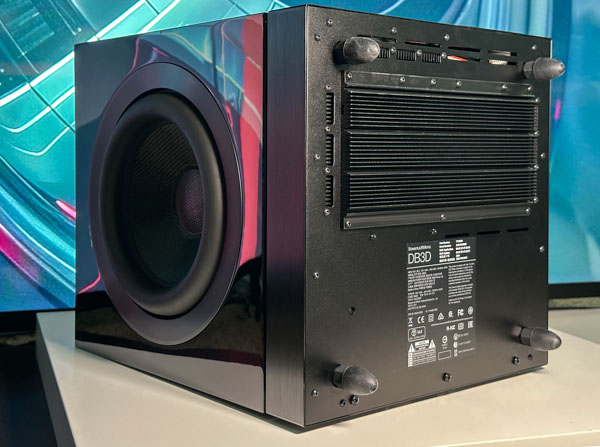
The result is a dense cube, measuring 14.1 x 12.6 x 11.8 inches and weighing 55 pounds. Finish options include gloss black, satin white, and rose nut —seamlessly matching the looks of 700 Series S3 speakers. Inputs include dual XLR and RCA, alongside a 12-volt trigger and RS-232 connector, catering to custom installs and automation.
Owing to the relevant law of subwoofer physics that states “there’s no replacement for displacement,” pressurizing a room to create visceral infrasonic experiences requires the use of multiple DB3D subs to effortlessly fill this gap.
There are two larger models in the series: the dual 10-inch driver DB2D and dual 12-inch DB1D. All three subwoofers sport the exact same frequency response specification: 10 Hz to 350 Hz. It’s a strong hint that a carefully tuned DSP is in charge of the show as the amp and drivers plumb the depths. A 1,000 watt (peak) class D Hypex amplifier provides the electrons. With such a small yet powerful sub, high-efficiency amplification is important because there’s not a lot of surface area to dissipate heat.
With this sub, you get unbalanced RCA and balanced XLR inputs on the rear panel. For any long run, balanced connections are better because they intrinsically resist electromagnetic interference.
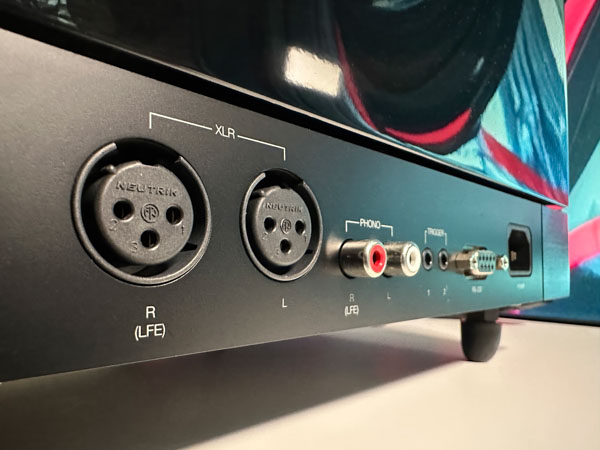
Setup
Ease and flexibility of setup and placement is the name of the game with these subwoofers. They are capable of delivering full-range frequency response, all the way down to 20Hz (and below).
The room tuning might make you nervous because it uses the phone’s mic. No need, it cleverly calibrates the phone by having you place it on the edge of the sub and playing a sweep it records nearfield.
Since the Marantz AV10 processor I used has four XLR outputs for subs, that’s the wiring option I chose. But I also briefly connected one sub with a 30-foot RCA cable to see how that worked. Happily, I heard no hum.
When tuning with the app, you get the benefit of deciding to focus the bass response on a single seat, in a tight area like a couch, or spread around the room across multiple seats. Measurements only take a minute or two to perform, and the app shows you the frequencies where compensation is applied (via a minimalist graphic). The results agreed with what the Audyssey XT32 found when I ran it on the uncorrected subs with the Marantz AV10.
I ran the Audyssey setup again after tuning each of the four subs using the dB Sub app. The difference is apparent in the amount of correction Audyssey subsequently applied. The starting point is a lot more linear. So the correction Audyssey applies is also less extreme. The combined correction is smoother than using just one correction system or the other.
One thing I want to stress is that this sub’s built-in room tuning capability also makes it a great choice to use in a minimalist 2-channel system, for example, self-powered speakers with a subwoofer-out or a streaming amp that does not have room correction among its features. You can achieve a far more optimal sound with a self-tuning sub, especially if you focus on optimal response at the main listening position.
Performance
As noted earlier, reproducing bass below 20 Hz is usually off-limits to a sub this size. But, with a kilowatt of power on tap, the DB3D’s ultra-rigid Aerofoil cones overcome the air-spring effect of the small enclosure. And keep in mind the sub's already small interior is partly filled with the drivers and the amp, it’s not just empty space in there.
The frequency response is truly impressive, ranging from 10 Hz to 350 Hz (–3 dB). This is verified by multiple rounds of room correction measurements. I have seen other subwoofers with similar specifications, where the cones barely start moving at that frequency. Or subs that produce so much mechanical noise dipping below the infrasonic threshold that you are mostly listening to distortion, not bass.
Crucially, with the DB3D I can’t actually hear anything mechanical, even with pure sine waves at 10 Hz. If you spend big bucks on subs, covering the range you can hear is a must! Anything you get below what’s humanly audible is a bonus. The DB3D plays cleanly and with ease to 16 Hz, so even one sub legitimately turns a pair of good speakers into a true full-range system.
The total surface area of these four subs is equivalent to a single 22.6-inch driver, or else dual 16-inch drivers. For real! There is no way I can fit a 22-inch subwoofer in my living room. And dual 16-inch subs? As awesome as that approach is, it would be very difficult because the spots I have to put four subs are not that large. The flexibility in placement the DB3D offers ensures that the four subwoofers can be optimally positioned for the best acoustic impact—including directional bass—regardless of room layout or constraints.
In a full 5.4-speaker system, including Bowers & Wilkins 703 S3 towers, 705 S3 bookshelf speakers, and a HTM71 center channel — all driven by a Marantz AV-10 pre-pro and amp-10 home theater amplifier — the four DB3D subs provided the rock-solid foundation for a superb ultra-high-performance system.
Movies
For movies, the DB3D has it all. Power, finesse, depth, texture, delivered with ease. Take Maestro for instance, and Bradley Copper’s performance as Leonard Bernstein conducting Mahler’s Second Symphony. The crescendo pushed the system (and my neighbor’s patience) to its limits. Limits I rarely test, where there’s a feeling the entire room’s air mass is moving in unison.
Screening Oppenheimer shook the senses. Nolan, known for putting sound effects and music above chatter, skips Dolby Atmos. Yet, in a commercial Dolby Cinema amphitheater, where I saw it debut, Oppenheimer’s sound was top-notch with bass that made it feel as if there are actuators under the seats (there are not). At home, this system matched that feeling. It’s not just sound in the air; like with Maestro it’s a feeling, deep in your bones.
And the classic but re-released Aliens with Atmos sound? The DB3Ds added a whole new layer of thrill, turning suspense into a physical sensation. When the atmosphere processor explodes at the culmination of James Horner’s orchestral buildup, goosebumps ensue.
Music
Flashback to 30 years ago, when I bought my first Bowers & Wilkins subwoofers—a pair of Acoustitune passive subs. From then onward, I have religiously checked out Coil’s track “Her Friends the Wolves” from the album Stolen and Contaminated Songs. When the track gets going — which takes a while — a dry, growling, “edge of the infrasonic threshold”-type bassline settles in. A lot of systems miss it altogether. The effortless rendering of the full bass palette of this classic track represents endgame-quality fidelity.
With music, one DB3D makes a great pairing for a 2.1 sub/sat system featuring a pair of the 705 S3 speakers. For even more impact, a pair of DB3Ds offer just the right amount of oomph when matched up with the 703 S3 towers I used for my two-channel music sessions.
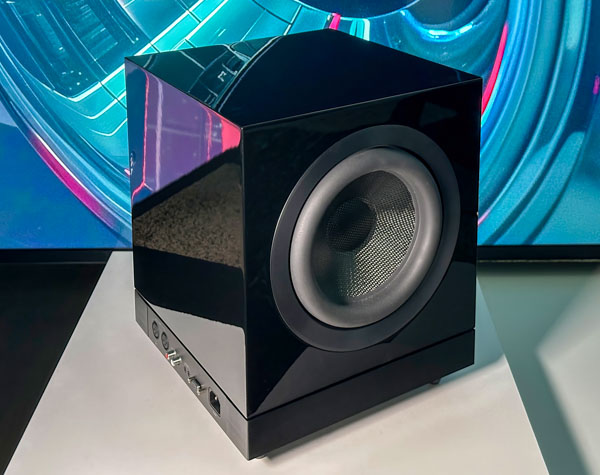
But, cost notwithstanding, four DB3D subs is certainly where it’s at for sublime bass that is consistent, effortless, seemingly bottomless. And with so much music now released in Atmos, you can leverage a multi-channel and multi-sub system to its full capacity.
Conclusion
The Bowers & Wilkins DB3D is a marvel in the world of compact, high-performance subwoofers. For those valuing aesthetics, space efficiency, and deep, clear bass, it’s an investment worth considering. Its design aligns with the needs of users who want to integrate high-quality audio into their space without compromising on style.
Bowers & Wilkins have once again proven its prowess in the subwoofer domain, a journey I’ve personally witnessed since owning their Acoustitune subs. With the DB3D, they’ve not just created a subwoofer; they’ve sculpted a compact acoustic masterpiece for the discerning audiophile. Its deep, clear bass makes it a valuable addition to any sophisticated audio setup.
Specs
Frequency response: 10 Hz to 350 Hz (-3 dB)
Power output: 1,000 watts (peak)
Inputs: Dual XLR, dual RCA
Dimensions: 14.1 x 12.6 x 11.8 inches
Weight: 55 pounds


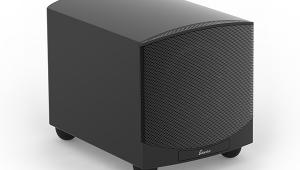
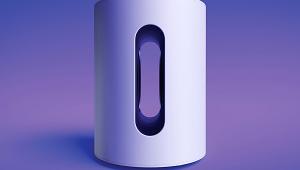
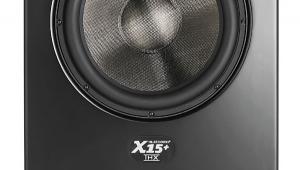
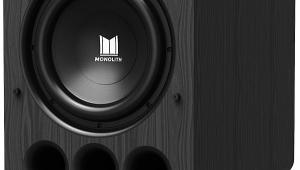

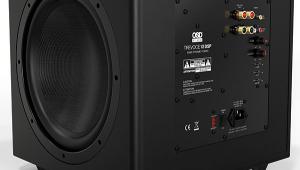



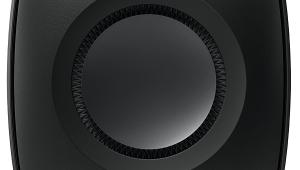


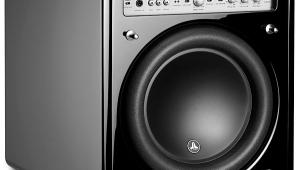
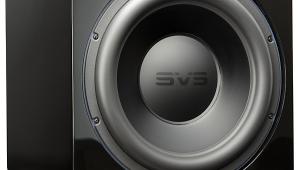
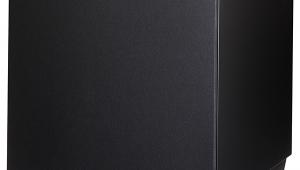




























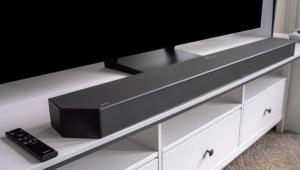
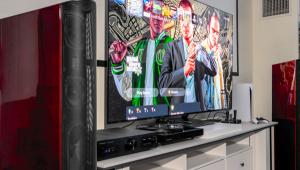























Great! Another glowing review of a $3500, 8 inch subwoofer. This system should not exist.
For $2400, you could buy four Rythmik L12 subs that willl outperform the four subs you listened to and do it by a good margin. I’m not just talking about playing, louder or deeper, I’m talking about doing it with a lot less distortion because Rythmiks are servo subs.
If you were to buy Rythmik’s best 12 inch subwoofer, for $1100, it would eviscerate this subwoofer. If you were to get four of them and still save almost $10,000 compared to these B&W’s, all four of the subs that you tested would not even come close to the performance that you would get from the Rythmik subs.
Hang your head in regret and shame.